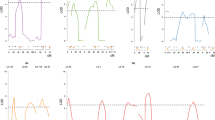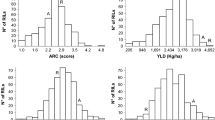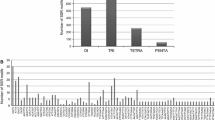Abstract
Cabbage heading traits are important quantitative traits that greatly affect both quality and yield of cabbage. However, the genetic control of these traits remains unclear. To detect quantitative trait loci (QTLs) associated with heading traits, a double haploid (DH) population with 196 lines was created from a cabbage hybrid 01–20 × 96–100. A genetic map with insertion–deletion and simple sequence repeat markers was constructed based on the DH population, with a total length of 934.06 cM and average interval length of 2.3 cM between adjacent markers. Field experiments in three seasons were carried out to evaluate the heading traits, including head mature period (Hm), head weight (Hw), core length (Cl), head vertical diameter (Hvd), and the ratio of Cl to Hvd (Cl/Hvd). Using the map and the trait data, 13 reliable QTLs in total were identified and 5 were found in more than one season based on the adjusted means of three seasons. Major QTLs were identified for Hm (R 2 = 40.4, LOD = 14.84), Hw (R 2 = 28.6, LOD = 9.83), Cl (R 2 = 38.8, LOD = 15.73), Hvd (R 2 = 19.2, LOD = 9.26), and Cl/Hvd (R 2 = 38.8, LOD = 12.75). The most significant QTLs were Hm3.1, Cl3.1, and Cl/Hvd3.1, which were detected in three seasons with the maximum contribution rate of almost 40 %. Six active regions that harbored more than one QTL were identified on five chromosomes, and one of them contained major QTLs associated with five traits. The QTLs obtained in this study should be useful for marker-assisted selection in cabbage breeding and for understanding the genetic control of these traits.

Similar content being viewed by others
References
Andolfatto P (2001) Adaptive hitchhiking effects on genome variability. Curr Opin Genet Dev 11:635–641
Bohuon EJR, Ramsay LD, Craft JA, Arthur AE, Marshall DF, Lydiate DJ, Kearsey MJ (1998) The association of flowering time quantitative trait loci with duplicated regions and candidate loci in Brassica oleracea. Genetics 150:393–401
Brant JB, Gustavo CA, Peter MG (1991) Fast and sensitive silver staining of DNA in polyacrylamide gels. Anal Biochem 196:80–83
Camargo LEA, Osborn TC (1996) Mapping loci controlling flowering time in Brassica oleracea. Theor Appl Genet 92(5):610–616
Chen S, Wang X, Fang Z, Cheng Z, Sun P (2002) Construction of molecular linkage map of Brassica oleracea var. alboglabra × B. oleracea var. capitata by RAPD analysis. Acta Horticulturae Sinica 29(3):229–232
Chen C, Zhuang M, Fang ZY, Wang QB, Zhang YY, Liu YM, Yang LM, Cheng F (2013) A co-dominant marker BoE332 applied to marker-assisted selection of homozygous male-sterile plants in cabbage (Brassica oleracea var. capitata L.). J Integr Agric 12(4):596–602
Cheung W, Champagne G, Hubert N, Landry B (1997) Comparison of the genetic maps of Brassica napus and Brassica oleracea. Theor Appl Genet 94(5):569–582
Christopher M, Mace E, Jordan D, Rodgers D, McGwan P, Delacy L, Banks P, Sheppard J, Butler D, Poulsen D (2007) Applications of pedigree-based genome mapping in wheat and barley breeding programs. Euphytica 154:307–316
Ellegren H (2004) Microsatellites: simple sequences with complex evolution. Nat Rev Genet 5:435–445
Foisset N, Delourme R, Barret P, Hubert N, Landry BS, Renard M (1996) Molecular-mapping analysis in Brassica napus using isozyme, RAPD and RFLP markers on a doubled-haploid progeny. Theor Appl Genet 93:1017–1025
Gebhardt C, Bellin D, Henselewski H, Lehmann W, Schwarzfischer J, Valkonen JPT (2006) Marker-assisted combination of major genes for pathogen resistance in potato. Theor Appl Genet 112:1458–1464
Holme IB, Torp AM, Hansen LN, Andersen SB (2004) Quantitative trait loci affecting plant regeneration from protoplasts of Brassica oleracea. Theor Appl Genet 108:1513–1520
Kifuji Y, Hanzawa H, Terasawa Y, Ashutosh, Nishio T (2013) QTL analysis of black rot resistance in cabbage using newly developed EST-SNP markers. Euphytica 196:289–295
Kosambi DD (1944) The estimation of map distances from recombination values. Ann Eugen 12(1):172–175
Lam HM, Xu X, Liu X, Chen WB, Yang GH (2010) Resequencing of 31 wild and cultivated soybean genomes identifies patterns of genetic diversity and selection. Nat Genet 42(12):1053–1059
Lan TH, Paterson AH (2001) Comparative mapping of QTLs determining the plant size of Brassica oleracea. Theor Appl Genet 103:383–397
Landry B (1992) A genetic map for Brassica oleracea based on RFLP markers detected with expressed DNA sequences and mapping of resistance genes to race 2 of Plasmodiophora brassicae (Woronin). Genome 35:409–420
Li XX, Fang ZZ (2007) Descriptors and data standards for cabbage (Brassica oleracea L. var. capitata L. and Brassica oleracea L. var. gemmifera Zenk). China Agriculture Press, Beijing
Li HH, Chen C, Yang Y, Xu JS, Gu JX, Fu J, Qian XJ, Zhang SC, Wu JS, Liu KD (2011) Development and genetic mapping of microsatellite markers from whole genome shotgun sequences in Brassica oleracea. Mol Breed 28:585–596
Liu B, Wang Y, Zhai W, Deng J, Wang H, Cui Y, Cheng F, Wang X, Wu J (2013) Development of InDel markers for Brassica rapa based on whole-genome re-sequencing. Theor Appl Genet 126:231–239
Lukens LN, Doebley J (2001) Molecular evolution of the teosinte branched gene among maize and related grasses. Mol Biol Evol 18:627–638
Moriguchi K, Kimizuka-Takagi C, Ishii K, Nomura K (1999) A genetic map based on RAPD, RFLP, isozyme, morphological markers and QTL analysis for clubroot resistance in Brassica oleracea. Breed Sci 49(4):257–265
Nagaoka T, Doullah MAU, Matsumoto S, Kawasaki S, Ishikawa T, Hori H, Okazaki K (2010) Identification of QTLs that control clubroot resistance in Brassica oleracea and comparative analysis of clubroot resistance genes between B. rapa and B. oleracea. Theor Appl Genet 120:1335–1346
Okazaki K, Sakamoto K, Kikuchi R, Saito A, Togashi E, Kuginuki Y, Matsumoto S, Hirai M (2007) Mapping and characterization of FLC homologs and QTL analysis of flowering time in Brassica oleracea. Theor Appl Genet 114:595–608
Palaisa K, Morgante M, Tinggey S, Rafalski A (2004) Long-range patterns of diversity and linkage disequilibrium surrounding the maize Y1 gene are indicative of an asymmetric selective sweep. Proc Natl Acad Sci USA 101:9885–9890
Pestsova E, Röder M (2002) Microsatellite analysis of wheat chromosome 2D allows the reconstruction of chromosomal inheritance in pedigrees of breeding programmes. Theor Appl Genet 106:84–91
Saghai Maroof MA, Soliman KM, Jorgensen RA, Allard RW (1984) Ribosomal DNA spacer-length polymorphisms in barley: Mendelian inheritance, chromosomal location, and population dynamics. Proc Natl Acad Sci USA 81:8014–8018
Singh AL, Basu MS, Singh NB (2004) Mineral disorders of groundnut. National Research Center for Groundnut (ICAR), Junagadh, p 85
Slocum M, Figdore S, Kennard W, Suzuki J, Osborn T (1990) Linkage arrangement of restriction fragment length polymorphism loci in Brassica oleracea. Theor Appl Genet 80(1):57–64
Syvänen AC (2004) Accessing genetic variation: genotyping single nucleotide polymorphisms. Nat Rev Genet 2(12):930–942
Takahata Y, Keller WA (1991) High frequency embryogenesis and plant regeneration in isolated microspore culture of Brassica oleracea L. Plant Sci 74:235–242
Uptmoor R, Schrag T, Hartmut S, Elisabeth E (2008) Crop model based QTL analysis across environments and QTL based estimation of time to floral induction and flowering in Brassica oleracea. Mol Breed 21:205–216
Väli Ü, Brandström M, Johansson M, Ellegren H (2008) Insertion–deletion polymorphisms (indels) as genetic markers in natural populations. BMC Genet 9:8
Van Ooijen JW (1992) Accuracy of mapping quantitative trait loci in autogamous species. Theor Appl Genet 84(7–8):803–811
Van Ooijen JW (2006) JoinMap 4, software for the calculation of genetic linkage maps in experimental populations. Kyazma BV, Wageningen
Van Ooijen JW, Boer MP, Jansen RC, Maliepaard C (2002) Map QTL 4·0: software for the calculation of QTL positions on genetic maps. Plant Research International, Wageningen
Voorrips R, Jongerius M, Kanne H (1997) Mapping of two genes for resistance to clubroot (Plasmodiophora brassicae) in a population of doubled haploid lines of Brassica oleracea by means of RFLP and AFLP markers. Theor Appl Genet 94(1):75–82
Wang XW, Fang ZZ, Huang SW, Sun PT, Liu YM, Yang LM, Zhuang M, Qu DY (2000) An extended random primer amplified region (ERPAR) marker linked to a dominant male sterility gene in cabbage (Brassica oleracea var. capitata). Euphytica 112(3):267–273
Wang W, Huang S, Liu Y, Fang Z, Yang L, Hua W, Yuan S, Liu S, Sun J, Zhuang M, Zhang Y, Zeng A (2012) Construction and analysis of a highdensity genetic linkage map in cabbage (Brassica oleracea L. var. capitata). BMC Genomics 13:523
Acknowledgments
This work was financially supported by grants from Major State Basic Research Development Program (973 Program, 2012CB113906), the National Natural Science Foundation of China (31272180), the National High Technology Research and Development Program of China (863 Program, 2012AA100102, 2012AA100202), the Key Projects in the National Science & Technology Pillar Program during the Twelfth Five-Year Plan Period (2012BAD02B01), and the earmarked fund for the Modern Agro-Industry Technology Research System, China (nycytx-35-gw01). The work reported here was done in the Key Laboratory of Biology and Genetic Improvement of Horticultural Crops, Ministry of Agriculture, Beijing 100081, China.
Author information
Authors and Affiliations
Corresponding author
Additional information
Honghao Lv and Qingbiao Wang have contributed equally to this work.
Electronic supplementary material
Below is the link to the electronic supplementary material.
Rights and permissions
About this article
Cite this article
Lv, H., Wang, Q., Zhang, Y. et al. Linkage map construction using InDel and SSR markers and QTL analysis of heading traits in Brassica oleracea var. capitata L.. Mol Breeding 34, 87–98 (2014). https://doi.org/10.1007/s11032-014-0019-1
Received:
Accepted:
Published:
Issue Date:
DOI: https://doi.org/10.1007/s11032-014-0019-1




